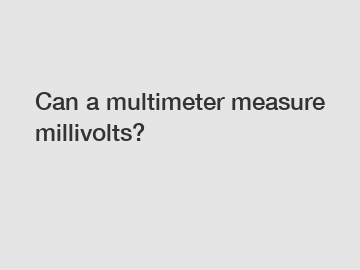Jan. 27, 2024
Electrical Equipment
For more information, please visit SUIN.
Can a Multimeter Measure Millivolts?
If you are a technician, engineer, or electronics enthusiast, you've probably encountered the term "millivolts" multiple times in your work. Millivolts, abbreviated as mV, represent a small unit of electrical potential. But can a multimeter, the trusty tool of every electrician, accurately measure millivolts? Let's dive into the world of multimeters and explore this concept in detail.

First things first, let's understand the basic principles of a multimeter. A multimeter is an essential device used to measure various electrical quantities, including voltage, current, and resistance. It consists of a digital or analog display, probes or leads, and a selection dial to set the desired measurement mode.
When it comes to measuring millivolts, most multimeters handle this task with ease. In fact, measuring millivolt levels is one of the primary functions of a multimeter. Whether you are dealing with small electronic circuits or testing the output of a power source, a multimeter will come to your rescue by providing accurate millivolt measurements.
One of the key features to consider when selecting a multimeter for measuring millivolts is its voltage range. Typically, multimeters have different voltage ranges, such as 200mV, 2V, 20V, 200V, and so on. To measure millivolts, you should select the appropriate voltage range on your multimeter that corresponds to the expected millivolt level of the circuit or device under test.
Now, let's delve a bit deeper into the technical side of multimeters. To measure millivolts accurately, multimeters use precision analog-to-digital converters (ADC) and amplifiers. ADCs convert the analog millivolt signal into a digital representation that can be displayed on the multimeter's screen. The amplifiers in the multimeter ensure that the small millivolt signal is boosted to a more manageable level for the ADC.
The ability of a multimeter to measure millivolts accurately also depends on its resolution. The resolution is essentially the smallest change in voltage that the multimeter can detect and display. For instance, if a multimeter has a resolution of 0.1mV, it means it can measure changes as small as 0.1mV accurately. Higher resolution multimeters offer more precise measurements in the millivolt range, enabling you to detect even slight voltage variations.
It's important to note that the accuracy of a multimeter's millivolt measurement can be affected by various factors. One such factor is internal noise. Every electronic device generates a certain amount of noise, and multimeters are no exception. This internal noise can introduce errors into the millivolt measurement, especially when dealing with very low-level signals.
To overcome this limitation, it is crucial to ensure a stable and noise-free measurement environment. Minimizing electromagnetic interference and using high-quality leads and probes can significantly improve the accuracy of millivolt measurements. Additionally, averaging multiple readings and taking precautionary measures, such as grounding the circuit or shielding the multimeter, can further enhance accuracy.
To summarize, multimeters are indeed capable of measuring millivolts with high accuracy and precision. They are designed to handle small voltage levels, and their inclusion of ADCs and amplifiers enables accurate measurements in the millivolt range. However, it is essential to consider the voltage range, resolution, and environmental factors to obtain reliable millivolt measurements.
As with any measurement, it is always good practice to consult the multimeter's user manual for specific instructions on millivolt measurement techniques. Furthermore, verifying the accuracy of your multimeter by comparing its readings with a known reference source is recommended for critical measurements.
In conclusion, a multimeter is a versatile tool that can accurately measure millivolts. Whether you are troubleshooting electronics, testing sensors, or analyzing power sources, a multimeter will prove invaluable with its ability to provide accurate millivolt measurements. Remember to choose the appropriate voltage range, ensure a noise-free environment, and refer to the user manual to make the most of your multimeter's millivolt measuring capabilities.
For more information, please visit our website.
Want more information on Pulse Pattern Generator? Feel free to contact us.
Previous: Which 3.2v Lifepo4 280ah battery offers the best value for B2B purchase?
Next: Unlock Ultimate Comfort: Top Techniques for Effective Vibration Damping!
If you are interested in sending in a Guest Blogger Submission,welcome to write for us!
All Comments ( 0 )